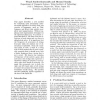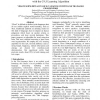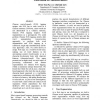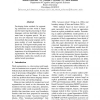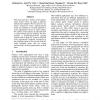EMNLP
2010
13 years 10 months ago
2010
Almost all Chinese language processing tasks involve word segmentation of the language input as their first steps, thus robust and reliable segmentation techniques are always requ...
CORR
2002
Springer
14 years 7 days ago
2002
Springer
Given the lack of word delimiters in written Japanese, word segmentation is generally considered a crucial first step in processing Japanese texts. Typical Japanese segmentation a...
COLING
2002
14 years 8 days ago
2002
It is commonly believed that word segmentation accuracy is monotonically related to retrieval performance in Chinese information retrieval. In this paper we show that, for Chinese...
COLING
1996
14 years 1 months ago
1996
This paper describes a new method for extracting open compounds (uninterrupted sequences of words) from text corpora of languages, such as Thai, Japanese and Korea that exhibit un...
COLING
1994
14 years 1 months ago
1994
This paper describes a set of computer programs for Chinese corpus analysis. These programs include (1) extraction of different characters, bigrams and words; (2) word segmentatio...
ACL
1997
14 years 1 months ago
1997
This paper presents a trainable rule-based algorithm for performing word segmentation. The algorithm provides a simple, language-independent alternative to large-scale lexicai-bas...
COLING
2000
14 years 1 months ago
2000
"Word" is difficult to define in the languages that do not exhibit explicit word boundary, such as Thai. Traditional methods on defining words for this kind of languages...
EMNLP
2004
14 years 1 months ago
2004
Chinese part-of-speech (POS) tagging assigns one POS tag to each word in a Chinese sentence. However, since words are not demarcated in a Chinese sentence, Chinese POS tagging req...
ACL
2006
14 years 1 months ago
2006
Developing better methods for segmenting continuous text into words is important for improving the processing of Asian languages, and may shed light on how humans learn to segment...
ACL
2004
14 years 1 months ago
2004
This paper presents a Chinese word segmentation system which can adapt to different domains and standards. We first present a statistical framework where domain-specific words are...

